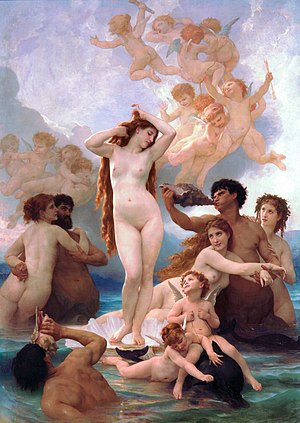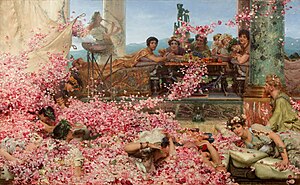
Back فن أكاديمي Arabic فن اكاديمى ARZ Academicismu AST Akademizm Azerbaijani Акадэмізм Byelorussian Академично рисуване Bulgarian শিক্ষায়তনিক শিল্পকর্ম Bengali/Bangla Arz akademiek Breton Академизм BXR Academicisme Catalan
This article needs additional citations for verification. (October 2022) |
The Birth of Venus by William-Adolphe Bouguereau (1879); Phaedra by Alexandre Cabanel (1880); The Roses of Heliogabalus by Lawrence Alma-Tadema (1888) |
Academic art, academicism, or academism, is a style of painting and sculpture produced under the influence of European academies of art. This method extended its influence throughout the Western world over several centuries, from its origins in Italy in the mid-16th century, until its dissipation in the early 20th century. It reached its apogee in the 19th century, after the end of the Napoleonic Wars in 1815. In this period, the standards of the French Académie des Beaux-Arts were very influential, combining elements of Neoclassicism and Romanticism, with Jean-Auguste-Dominique Ingres a key figure in the formation of the style in painting. The success of the French model led to the founding of countless other art academies in several countries. Later painters who tried to continue the synthesis included William-Adolphe Bouguereau, Thomas Couture, and Hans Makart among many others. In sculpture, academic art is characterized by a tendency towards monumentality, as in the works of Auguste Bartholdi and Daniel Chester French.
The academies were established to replace medieval artists' guilds and aimed to systematize the teaching of art. They emphasized the emulation of established masters and the classical tradition, downplaying the importance of individual creativity, valuing instead collective, aesthetic and ethical concepts. By helping raise the professional status of artists, the academies distanced them from artisans and brought them closer to intellectuals. They also played a crucial role in organizing the art world, controlling cultural ideology, taste, criticism, the art market, as well as the exhibition and dissemination of art. They wielded significant influence due to their association with state power, often acting as conduits for the dissemination of artistic, political, and social ideals, by deciding what was considered "official art". As a result, they faced criticism and controversy from artists and others on the margins of these academic circles, and their restrictive and universalist regulations are sometimes considered a reflection of absolutism.
Overall, academicism has had a significant impact on the development of art education and artistic styles. Its artists rarely showed interest in depicting the everyday or profane. Thus, academic art is predominantly idealistic rather than realistic, aiming to create highly polished works through the mastery of color and form. Although smaller works such as portraits, landscapes and still-lifes were also produced, the movement and the contemporary public and critics most valued large history paintings showing moments from narratives that were very often taken from ancient or exotic areas of history and mythology, though less often the traditional religious narratives. Orientalist art was a major branch, with many specialist painters, as were scenes from classical antiquity and the Middle Ages. Academic art is also closely related to Beaux-Arts architecture, as well as classical music and dance, which developed simultaneously and hold to a similar classicizing ideal.
Although production of academic art continued into the 20th century, the style had become vacuous, and was strongly rejected by the artists of set of new art movements, of which Realism and Impressionism were some of the first. In this context, the style is often called "eclecticism", "art pompier" (pejoratively), and sometimes linked with "historicism" and "syncretism". By World War I, it had fallen from favor almost completely with critics and buyers, before regaining some appreciation since the end of the 20th century.


